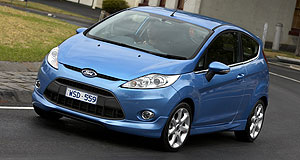
All guns blazing, Ford Australia hits back with its all-new global B-segment hatchBy BYRON MATHIOUDAKIS 15 December 2008Story Source: GoAutoUNDERLINED by its international ‘This Is Now’ ad campaign, Ford Australia believes the new WS-series Fiesta is the right light-car in the right place at the right time.Presented to the Australian media in Adelaide last week, but not slated for sale until late January, the German-built hatchback range arrives just three months after its global debut in Europe.Prices kick off from $15,750 for the base Fiesta CL, culminating (for now) in the $20,990 Zetec. Choosing an automatic adds $1500, while adding two more doors to the CL and Zetec costs another $740.Developed under the ‘One Ford’ regime that aims to slash inefficiencies and streamline global model line-ups, this fourth-generation “Mark Six” Fiesta’s mission is to turn Ford around – and fast.That is why the baby Ford is in Australia in record time, aggressively priced, brashly styled and lavishly equipped with multimedia connectivity and excellent crash-test results to impress younger buyers and the older demographic alike.No light-car available in Australia right now can be had with the combination of stability control, MP3, Bluetooth and voice-control connectivity, cruise control and a five-star Euro NCAP adult occupant safety rating (safety pack models only).Currently, the Fiesta also leads in ENCAP child safety (four stars) and is pedestrian-impact competitive (three stars), thanks to an energy-absorbent front bumper, a specially designed bonnet and the careful rearrangement of likely engine-bay hard-points.However, unlike its DE-series Mazda2 cousin with which it shares around 50 per cent of parts, the Fiesta forgoes curtain airbags; head and thorax-protecting side airbags are for the front occupants only, as are whiplash-reducing and anti-submarining seats and a special carpet underlay designed to lessen lower-leg injuries.Mirroring the Mazda, though, the Ford is lighter than its predecessor, by approximately 40kg.This has been achieved through the adoption of a lighter body structure employing high-strength and ultra high-strength steels – with a welcome 10 per cent torsion stiffness increase to boot.Particular attention has been paid to beefing up the A and B-pillars, rocker panels, rocker baffles, side roof arch, lower A-pillar area and floor pan.The mass exodus has allowed Ford to fit around 5kg of extra sound deadening, along with double door seals, fully encapsulated glass, and a secondary bulkhead barrier, in order to quell road and mechanical noise intrusion into the cabin.Cutting wind noise was a further priority, with detailed work in this area carried out at component level in order to create a quieter car “…even before the first prototype was built,” according to Ford.The company says the Fiesta achieves class-best front-seat articulation indexation, with rear-sited passengers able to experience easily audible conversation with the people in front.Reducing weight also means that while power and torque outputs rise in the manual-only 1.6-litre models, fuel consumption and carbon dioxide figures fall.And although the automatic-only 1.4-litre WS Fiesta is not as powerful as the old 1.6-litre WQ auto, it too is significantly more economical and less polluting, as Ford strives to slash European consumer-penalising carbon dioxide (CO2) emissions.Furthermore, our Fiesta will come out of Ford’s 100 per cent renewable-energy Cologne factory initially, before switching to the joint Ford/Mazda plant in Thailand from about 2010.It will also be built on three other continents and available on five, with the floundering United States market getting its first taste of a B-segment Ford in three decades.Ford Australia president and former global small-car line director Marin Burela said this Fiesta is the most significant vehicle for Ford since the Model T commenced mobilising the world 100 years ago.To aid the new Fiesta’s global reach, more body styles are on their way, including the recently unveiled four-door sedan and a tall wagon-esque mini-MPV that is expected to be called the B-Max, but for now the WS line-up in Australia is a hatch-only proposition.Compared to its WQ predecessor, the base CL in three and five-door guises is the new LX, the five-door-only LX is the new Ghia and the Zetec continues to be the saucy Fiesta, whether it comes as a manual-only three-door or manual-or-auto five-door.No XR4 or ST version has been announced as yet, but you can bet that small-capacity forced-induction Fiestas will be on their way in the not-too-distant future.Key length/width/height/wheelbase dimensions of 3950/1722/1481/2489mm mean the WS is around the same size as the WQ model (3924/1685/1468/2486mm).Styled under the watchful eye of ex-Audi designer Martin Smith (whose credits also include the acclaimed 1991 Audi Avus Quattro concept and current-generation Opel/Vauxhall/Holden Astra), the Fiesta is charged with visually enticing its way onto light-car buyers’ consideration lists.To that end, it features Ford’s Kinetic design language as introduced in production vehicles by the current Mondeo mid-sizer, espousing a gaping air-intake, setback headlights, large wheel-arches, a coupe-esque wedge profile, chamfered rear window and raised tail-lights – all of which is in stark contrast to the preceding Fiesta’s boxy, Teutonic, visage.The same is true inside, where an organic symmetry, soft surfaces and an eclectic use of trim and colour replace the hard if functional edges of the old car.Ford says it was inspired by mobile telephones and personal music players, and introduces a new level of interactivity and functionality to this class of car coined the Human Machine Interface (HMI).This includes a high-mounted screen that is sited above the audio and communication controls, which are laid out like “good portable electronic designs” for younger/technophile people to identify with.The instruments are bright and ‘binocular-shaped’ and are easily seen through a steering wheel that – on most models – contains all the essential remote switches as well as cruise control functions.


No comments:
Post a Comment